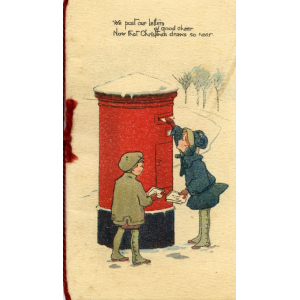‘We post our letters of good cheer/ Now that Christmas draws so near’. Early 20th century Christmas card.
© Royal Mail Group Ltd, courtesy of The Postal Museum, 2005-0101/2
In 1843 Henry Cole, who had campaigned along with Rowland Hill for the introduction of the Penny Post, invented the first Christmas card. The idea soon caught on and by the 1870s millions of cards were being sent during the festive season, as well as presents sent through the post. The heroic efforts of the mail coach battling through thick snow drifts to deliver the post even became one of the favourite themes portrayed on Victorian Christmas cards.
The massive increase in the number of letters that had to be sorted and delivered was an immense challenge for the Post Office. Year on year, the volume of mail at this time of the year kept on increasing. An article in The Manchester Guardian, published in September 1888, noted that:
‘The Christmas work was heavier than usual last winter, especially at the chief office in London. It is estimated that upwards of 41 millions of letters, parcels, &c., over and above the usual numbers were dealt with in London during the Christmas season…’[1]
As the volume of mail increased, the Post Office made a number of adjustments to ease the burden. For one thing, ‘the regular staff was supplemented by 3,095 persons temporarily employed for a few weeks; and the ordinary force of 435 mail vehicles in London was increased by 370 vehicles’ to facilitate the ‘great influx of extra matter’.[2] Instructions were also issued to the public. They were asked that they post their letters and other items early and were also reminded that certain items were forbidden from being sent through the Post due to the injuries that could arise because of poorly wrapped parcels – a problem that was accentuated during the Christmas period.[3] This list included, but was not limited, to glass bottles, leeches, and gunpowder.
Despite these measures, postal workers were hard pressed to keep up with the Christmas mail. Much had to be done in a short space of time, which placed workers under an immense amount of pressure.
‘[T]he great bulk of the work must be done during the small hours of the morning. The nerve strain is most acute at night, because then time is limited… The superintendent, apprehensive of a breakdown, moves nervously among the rows of workers at the fast-lightening tables, giving here a word of encouragement and there a rebuke, often giving a helping hand to a perspiring mail porter…’[4]
The hard work involved in dealing with the mail meant that there was often little time for the workers to enjoy the festivities themselves. As was noted, most of the workers concluded their postal activities utterly exhausted: ‘Hour after hour passes, until at last the cry goes up, “All through,” and completely worn out, the bulk of the indoor staff disperse to spend Christmas Day in bed.’[5]
That was if they managed to stay awake until the work was done. Sometimes, this was not the case, and their comrade the Post Office horse had to pull through instead: ‘Instances are not wanting where the driver has fallen asleep on his box and the horse has brought the Christmas mail through, unaided.’[6]
The families of postal workers also acknowledged the impact of the Christmas workload. Lilian Chambers was born in West Norwood in South London in 1892. Her father was the Postmaster for the West Norwood Post Office and so hard had he to work on getting the mail out that she recorded “Christmas day was a very quiet day for us…mother used to say, oh be very quiet, father’s very tired. And we’d have our Christmas dinner without him…’[7]
The Post Office was central to the Victorian and the Edwardian Christmas. This took its toll on the postal workers, but what is also clear is that they were very committed to supporting the festive season, and this was noted by onlookers as well. As one observer taking ‘a peep behind the scenes’ related, ‘everybody, down to the last recruited telegraph boy, catches the fever of enthusiasm, and as the tide of correspondence steadily rises, so also does the zeal and energy of the staff.’[8]
Postal workers provided an essential and much valued service to Victorian and Edwardian society, especially but not exclusively at Christmas – much as they still do today!
Natasha Preger
[1] ‘Work of the Post Office’, The Manchester Guardian (1 September 1888).
[2] ‘Work of the Post Office’.
[3] Charles Dickens, ‘By Parcels Post’, All The Year Round (22 December 1883), pp. 108 – 114.
[4] H. E. H., ‘Christmas in the Post Office’, The Pall Mall Magazine (December 1905), p. 696.
[5] H. E. H., ‘Christmas in the Post Office’, p. 696.
[6] H. E. H., ‘Christmas in the Post Office’, p. 698.
[7] ‘Interview with Mrs. Chambers’, Family Life and Work Experience Before 1918, 1870 – 1973 (2000).
[8] H. E. H., ‘Christmas in the Post Office’, p. 696.
